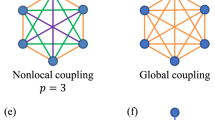Abstract
The analysis and results presented in this paper provide conclusive evidence to distinguish between the delay effect and the lag as two biologically distinct phenomena. It therefore dispels the incorrect notion that delay effects represented by delay differential equations are the biological reason behind the lag phase in microorganism growth. The resulting consequence so far is that the only other reason for the lag phase is the existence of unstable stationary states. The latter are a result of accounting for the microbial metabolic mass transfer in the population growth process.













Similar content being viewed by others
References
Baranyi J, Roberts TA (1994) A dynamic approach to predicting bacterial growth in food. Int J Food Microbiol 23:277–294
Bellman R, Cooke KL (1963) Differential-difference equations. Academic, New York
Gompertz B (1825) On the nature of the function expressive of the law of human mortality, and a new mode of determining the value of life contingencies. Phil Trans Roy Soc London 115:513–583
Hutchinson GE (1948) Circular casual systems in ecology. Ann NY Acad Sci 50:211–246
Lebowitz JL, Rubinow SI (1974) A theory for the age and generation time distribution of a microbial population. J Math Biol 1:17–36
Lodge RM, Hinshelwood CN (1943) Physiochemical aspects of microbial growth. Part IX. The lag phase of Bact. lactis aerogenes. J Chem Soc 213–219
Maier RM (2000) Bacterial growth. In: Maier RM, Pepper IL, Gerba CP (eds) Environmental microbiology. Academic, New York, pp 43–59
Malthus TR (1798) An essay on the principle of population. Penguin, Harmondsworth
May MR (1973) Time-delay versus stability in population models with two and three trophic levels. Ecology 54:315–325
May MR (1978) Mathematical aspects of the dynamics of animal populations. In: Levin SA (ed) Studies in mathematical biology—part II: populations and communities, studies in mathematics, vol 16. The Mathematical Association of America, Washington, DC, pp 317–366
May MR (1981) Models for single populations. In: May RM (ed) Theoretical ecology. Blackwell Scientific, Oxford, pp 5–29
McKendrick AG (1926) Application of mathematics to medical problems. Proc Edinb Math Soc 44(1):98–130
O’Donovan L, Brooker JD (2001) Effect of hydrolysable and condensed tannins on growth, morphology and metabolism of Streptococcus gallolyticus (S. caprinus) and Streptococcus bovis. Microbiology 147:1025–1033
Pearl R (1927) The growth of populations. Q Rev Biol II(4):532–548
Pirt SJ (1975) Principles of microbe and cell cultivation. Wiley, New York p 11 & p 194
Thompson S, Shampine LF (2006) A friendly Fortran DDE solver. Appl Numer Math 56:506–516
Vadasz P, Vadasz AS (2002) The neoclassical theory of population dynamics in spatially homogeneous environments—part I: derivation of universal laws and monotonic growth. Physica A 309(3–4):329–359
Vadasz P, Vadasz AS (2002) The neoclassical theory of population dynamics in spatially homogeneous environments—part II: non-monotonic dynamics, overshooting and oscillations. Physica A 309(3–4):360–380
Vadasz P, Vadasz AS (2005) Predictive modeling of microorganisms: LAG and LIP in monotonic growth. Int J Food Microbiol 102:257–275
Vadasz P, Vadasz AS (2007) Biological implications from an autonomous version of Baranyi and Roberts growth model. Int J Food Microbiol 114:357–365
Vance RR, Newman WI, Sulsky D (1988) The demographic meanings of the classical population growth models of ecology. Theor Popul Biol 33:199–225
Verhulst PF (1838) Notice sur la loi que la population suit dans son accroissement. Corr Math et Phys Publ par A Quetelet T X 113–121
von Foerster H (1959) Some remarks on changing populations. In: Stohlman F Jr (ed) The kinetics of cellular proliferation. Grune & Stratton, New York, pp 382–407
Wangersky PJ, Cunningham WJ (1957) Time lag in population models. Cold Spring Harb Symp Quant Biol 22:329–338
Wood BD, Dawson CN, Szecsody JE, Streile GP (1994) Modeling contaminant transport and biodegradation in a layered porous media system. Water Resour Res 30(6):1833–1845
Wood BD, Ginn TR, Dawson CN (1995) Effects of microbial lag in contaminant transport and biodegradation modeling. Water Resour Res 31(3):553–563
Acknowledgments
One of the authors (PV) is grateful and sincerely expresses his gratitude to Professor Peter Chesson from University of Arizona for an insightful discussion on the topic.
This material is based upon work supported by the National Science Foundation under Grant No. CTS-0500466. The authors wish to thank the NSF for the funding support.
Author information
Authors and Affiliations
Corresponding author
Rights and permissions
About this article
Cite this article
Vadasz, P., Vadasz, A.S. On the Distinction Between Lag and Delay in Population Growth. Microb Ecol 59, 233–245 (2010). https://doi.org/10.1007/s00248-009-9592-y
Received:
Accepted:
Published:
Issue Date:
DOI: https://doi.org/10.1007/s00248-009-9592-y




